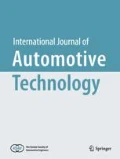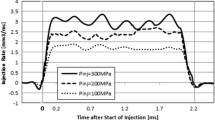Abstract
In diesel engine, spray penetration is usually changed by in-cylinder gas flow. Accurate prediction on diesel spray with gas flow is important to the optimal design of diesel fuel injection system. This paper presents a theory investigation focusing on the penetration of diesel spray with gas flow. In order to understand the effect of gas flow on the penetration of diesel spray, a one-dimensional spray model is developed from an idealized diesel spray, which is able to predict the spray behavior under different gas flow conditions. The ambient gas flow is simplified as ideal flow that has only constant flow velocity along x-axial and y-axial directions of spray. The x-axial and y-axial directions are respectively defined as along and vertical spray directions. The main assumption is that the y-axial direction gas flow has no effect on the penetration of spray along x-axial direction. The principles of conservation of mass and momentum are used in the derivation. Momentum of in-cylinder air flow is also taken into consideration. Validation of the model at stable condition is achieved by comparing model predictions with experimental measurements of diesel spray without gas flow from Naber's experiments. Furthermore, CFD simulations on penetration of diesel spray with gas flow were performed with the commercial code AVL-fire. The onedimensional model is validated by the penetration results with gas flow from CFD calculation. Results show that a reasonable estimation of the spray evolution can be obtained for both with and without ambient gas flow conditions.
Similar content being viewed by others
Abbreviations
- A:
-
cross-sectional area
- Ca:
-
orifice coefficient of area-contraction
- Cθ:
-
angle coefficient of spray
- d0:
-
orifice diameter
- df:
-
effective orifice diameter
- ṁ:
-
mass flux
- Ṁ:
-
momentum flux
- P:
-
pressure
- p, q:
-
defined parameter
- x':
-
distance along axial spray
- T:
-
temperature
- t:
-
time
- U:
-
velocity vector of spray
- u:
-
velocity vector of gas flow
- θ:
-
full cone angle of the real spray
- α:
-
full cone angle of the model spray
- ρ:
-
density
- x:
-
x-axis direction
- y:
-
y-axis direction
- r:
-
distance along the spray centerline
- f:
-
fuel
- a:
-
ambient gas
- 0:
-
exit of nozzle
- ξ:
-
area occupied by fuel
References
Borman, G. L. and Ragland, K. W. (1998). Combustion Engineering. McGraw-Hill. New York.
Dent, J. (1971). A basis for the comparison of various experimental methods for studying spray penetration. SAE Paper No. 710571.
Desantes, J. M., Arregle, J., Lopez, J. J. and Cronhjort, A. (2006). Scaling laws for free turbulent gas jets and diesel-like sprays. Atomization Spray 16, 4, 443–474.
Desantes, J. M., Lopez, J. J., Garcia, J. M. and Pastor, J. M. (2007). Evaporative diesel spray modeling. Atomization Spray 17, 3, 193–231.
Desantes, J. M., Pastor, J. V., García-Oliver, J. M. and Pastor, J. M. (2009). A 1D model for the description of mixing-controlled reacting diesel sprays. Combustion and Flame 156, 1, 234–249.
García-Oliver, J. M., Margot, X., Chávez, M. and Karlsson, A. (2011). A combined 1D3D–CFD approach for reducing mesh dependency in diesel spray calculations. Mathematical and Computer Modelling 54, 7-8, 1732–1737.
Hay, N. and Jones, P. (1972). Comparison of the various correlations for spray penetration. SAE Paper No. 720776.
Hiroyasu, H., Kadota, T. and Arai, M. (1980). Supplementary Comments: Fuel Spray Characterization in Diesel Engines. in James N. Mattavi and Charles A. Amann (eds.), Combustion Modeling in Reciprocating Engines. Plenum Press. New York. 369–408.
Lefebvre, A. H. (1989). Atomization and Sprays. Taylor and Francis. London.
Naber, J. and Siebers, D. (1996). Effects of gas density and vaporization on penetration and dispersion of diesel sprays. SAE Paper No. 960034.
Park, S. H., Yoon, S. J. and Lee, C. S. (2011). Effects of multiple-injection strategies on overall spray behavior, combustion, and emissions reduction characteristics of biodiesel fuel. Applied Energy 88, 1, 88–98.
Pastor, J. V., López, J. J., García, J. M. and Pastor, J. M. (2008). A 1D model for the description of mixingcontrolled inert diesel sprays. Fuel 87, 13-14, 2871–2885.
Payri, R., Salvador, F. J., Gimeno, J. and de la Morena, J. (2009). Effects of nozzle geometry on direct injection diesel engine combustion process. Applied Thermal Engineering 29, 10, 2051–2060.
Pickett, L., Genzale, C., Bruneaux, G., Malbec, L., Hermant, L., Christiansen, C. and Schramm, J. (2010). Comparison of diesel spray combustion in different high-temperature, high-pressure facilities. SAE Paper No. 2010-01-2106.
Reitz, R. and Diwakar, R. (1986). Effect of drop breakup on fuel sprays. SAE Paper No. 860469.
Sazhin, S. S., Feng, G. and Heikal, M. R. (2001). A model for fuel spray penetration. Fuel 80, 15, 2171–2180.
Sinnamon, J. F., Lancaster, D. R. and Stiener, J. C. (1980). An experimental and analytical study of engine fuel spray trajectories. SAE Paper No. 800135.
Takasu, Y., Kaneko, S., Tominaga, H., Namura, Y., Inagaki, K., Ueda, M. and Tani, T. (2013). Universal diesel engine simulator (UniDES) 2nd report: Prediction of engine performance in transient driving cycle using one dimensional engine model. SAE Paper No. 2013-01- 0881.
Yoshizaki, T., Nishida, K. and Hiroyasu, H. (1993). Approach to low NOx and smoke emission engines by using phenomenological simulation. SAE Paper No. 930612.
Author information
Authors and Affiliations
Corresponding author
Rights and permissions
About this article
Cite this article
Xu, M., Sun, Y.C., Cui, Y. et al. One-dimensional model on fuel penetration in diesel sprays with gas flow. Int.J Automot. Technol. 17, 109–118 (2016). https://doi.org/10.1007/s12239-016-0010-4
Received:
Revised:
Accepted:
Published:
Issue Date:
DOI: https://doi.org/10.1007/s12239-016-0010-4




